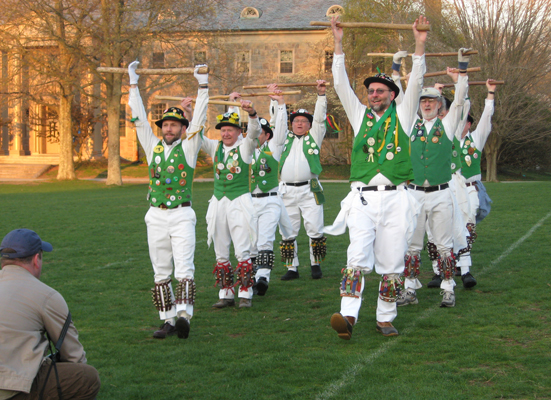| May Pole and May Day Festivities, Bryn Mawr College 1910 |
May Day in the 1950's
I remember making May Baskets in elementary school out of construction paper. I think the purpose of these baskets was for flowers--mostly dandelions or violets, which we were supposed to hang on the door knob on May Day. No May Pole, or much of anything else.May Day at Connecticut College
May Day had a little more more importance in college. A May Pole was set up on the big green overlooking Long Island Sound, and students danced around it in the early morning. Afterwards, strawberries and cream were served for breakfast in the dining halls. I never saw the May Pole--much too early in the morning for me, but I remember the very small and sour strawberries that were available in May in the 1960's. I checked my college yearbooks, no May Pole pictures, so I had to substitute the picture above from another woman's college May Day festivity. Today at Connecticut College, the May Day celebration continues, with the May Pole (still no pictures available) and the Westerly, RI, Morris Dancers, who have been dancing in May for the past 42 years on campus. |
| Westerly, RI, Morris Dancers, Performing on Tempel Green, Connecticut College, 2013. |
May Day in History
Celebrating May Day has ancient roots, it was a part of the Roman festival called Flora, which celebrated flowers, spring and fertility. Beltane, a Celtic festival, celebrated the beginning of summer. In Germany, a festival honoring St Walpurga, who helped bring Christianity to the German people was celebrated on the first of May. The Maypole and Morris dancing originated in Medieval England when people would go into the woods and bring out greens and flowers, which was referred to as "going a-maying". Some of these customs were brought to the United States by immigrants, but for the most part, they have faded away over the years. |
| Engraving showing May Day customs in England in the late 1700's. |
May 1: Labor Day/The International Worker's Day
May Day, the labor holiday, started in the United States, during the early days of the Labor Movement. Labor groups such as the Knights of Labor began to ask for an eight hour work day in the 1880s. |
All over America, On May 1, 1886, 300,00 workers walked off their jobs. In Chicago, the center of the eighth hour day movement, 40,000 workers went on strike. The numbers of strikers grew in the next few days, but no violence developed. On May 3, 1886, violence broke out between the police and the workers at the McCormick Reaper Works, when a bomb was thrown at a line of police. Many people were injured and 7-8 people people were killed including a policeman. Seven more policemen died of their injuries in the next few days. Eight anarchists were arrested and convicted of murder, one committed suicide and four were hanged on November 11, 1887. There was never proof that any of the people arrested and convicted had anything to do with the bombing, other than being anarchists and supporters of improving working conditions for laborers. Illinois Governor Altgeld pardoned the last three anarchists in November 1877, and was strongly criticized for his decision. In commemoration of what became known as the Haymarket Massacre, May 1 was established at International Workers' Day. It is celebrated all over the world, but not in the United States.
 |
| May Day in Istanbul, Turkey |
 |
| British labor poster listing the goals of the Labor Movement. |
No comments:
Post a Comment